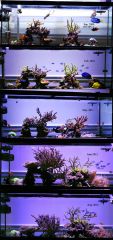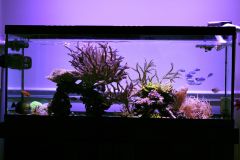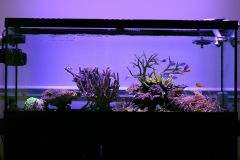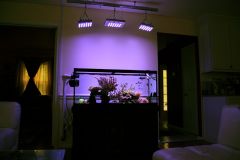-
Posts
428 -
Joined
-
Last visited
Content Type
Profiles
Forums
Gallery
Events
Store
Everything posted by chucelli
-
anytime. Just let me know. Thanks Tom. I really wanted to get some proper pics and maybe a video clip or two, but that would've involved turning on the main lights and disturbing all the fish. In hindsight, I think I could've lit the area with a flashlight and turned the pumps off until the eggs release. With the pumps on, the eggs would get blown away as soon as they are released and wouldn't have made a very good clip. Problem is, I rarely stay up this late, so I dont' know when I'll ever see this again! Hope everyone had a good turkey day. -Robert
-
thanks Jan
-
The tank has been set up for about 5 years. The current LEDs have been in service over this tank for 3 years. -Robert
-
Jan, I use a simplified version of the Balling method for alk, cal, and mag. I feed only dry flakes and pellets mixed with Cyclopes from an auto feeder 4 times a day. I dose 3 ml of vineger a day. The only other element I dose is iodine for a couple days right after I change the activated carbon. David, I don't have my lights on a lunar cycle. They are on a staggered schedule and ramp up and down for a total photo period of 13 hours, with only 4 hours of 100% intensity. The rest is ramping up and down. -Robert
-
around 2.5 hours after lights went out, I happened to still be awake and noticed eggs protruding from the largest branch of the A. Formosa. I didn't want to miss it so I grabed my camera, slapped the auto lens and set everything to full auto with flash and captured this: I managed to suck up one of the eggs and put it under the scope... not much to see since it's only back lit. You can however make out the soccerball like channels. 400X: This same area photographed when the lights are on: I don't believe the whole colony released eggs. I only noticed eggs protruding from this area. It seems to make sense the largest branches were the most well nourished and therefore released eggs. My parents are in town and asked if one colony had both males and females.... good question that I had no answer for... I don't think a single colony would release both eggs and sperm... but I've never seen footage of acros release sperm, only eggs... -Robert
-

may want to think twice before purchasing a clown goby
chucelli replied to chucelli's topic in General Discussion
This article is a bit more detailed: http://arstechnica.com/science/2012/11/chemical-warfare-on-the-reef/ -

may want to think twice before purchasing a clown goby
chucelli posted a topic in General Discussion
interesting read. http://www.livescience.com/24662-fish-bodyguards-protect-coral-from-seaweed-attack.html -
not sure about the smaller generators, but my generator has a fuel valve that lets you cut-off fuel supply into the fuel lines. This is what I do to switch off the generator before storing. It runs until all fuel lines are clear. -Robert
-
The point Tom made about total run time is actually more relevant than you can imagine. Being able to run through the night without refueling does wonders for piece of mind not to mention sleep. Getting a good night's sleep comes in handy when having to deal with this kind of situation during waking hours. It doesn't take much wattage wise to run most tanks, but IME, having a larger capacity generator not only allows you to run it through the night, but also allows you to plug in things like fridges, and space heaters if needed. This will also help justify the increased costs when negotiating with the other decision maker. -Robert
-
Nice, that is awesome. I needed a laugh today. -Robert
-
If your Scopas is still alive, I would recommend taping a piece of sheet mirror on one side of the tank. The yellow will focus its attacks against the glass. This will shift some aggression away from the newcomer. Once the yellow stops attacking its own image, you can remove it. By that time, aggression towards the newcomer will also have subsided. This is the method I used in the past with much success. It's worth a try... -Robert
-

Aluminum Channel size for DIY LED lighting fixture
chucelli replied to swffan's topic in Do It Yourself
Assuming you are using heavy gauge aluminum C channels (such as this 1-5/8" X 1-5/8"), 1 3w emitter per 4" is the general limit before you will get into cooling problems. This is also with the assumption that you are driving them at or around 700mA each. Lastly, depending on the type of emitters used (some are less efficient and will produce more heat at a particular current vs another), you may or may not hit the limit. If this emitter density (1 per 4") is not enough for your application, you will need to go with active cooling over heatsink. -Robert -
your snails bite?
-
If you want true macro pictures, it is hard to beat a good quality dedicated macro lens, but for shooting frags, a macro is not what I would use due to the very narrow depth of field. It makes it hard to get everything in focus without stopping it down a lot. Here is a a pic shot with a manual 50mm f/1.8 stopped down to f/4. The same pic cropped up close. You can get a bit closer than what is shown in this picture. The original pic above was not taken as close it could have been. I'm sure you can get better results too if you spent a bit of time in Photoshop. Obviously, a dedicated macro lens will get you better results if you want to go that close. Here is a pic taken with a NIKKOR 105mm f/2.8. (I don't remember the stop used on this pic.) Notice the narrow depth of focus. Now the same picture cropped close. It's obviously better quality than the 50mm just because you are truly focusing closer. You might want to also get some input by posting your question in the "Marine Photography" forums as there are some pro photographers here at WAMAS who can give you better insight... -Robert
-
Hi Rafal, I'm talking about something like the Nikon Series E 50mm f/1.8. You can find clean examples of these lenses at camera shops or ebay for around $50. It is all metal construction with very good optics and is tack sharp. You can't go wrong with the NIKKOR 50mm f/1.8D AF if you don't already have another AF lens for everyday shooting. It really depends on your budget. I will try to post some examples in a bit... -Robert
-
I would suggest getting a manual 50mm prime lens to start. They are cheap and offer better quality than most newer lenses. They are also among some of the sharpest lenses when stopped down a bit. The D90 offers enough MP to then crop a nice close-up. Finally, for tank shooting, I always manually focus anyways, which makes AF in a lens useless. -Robert
-
see the dead zone? You can try some gutter screening. Without it, that whole colony would be dead. -Robert
-
Just some food for thought when using other emitters other than the Crees everyone else seems to be using: The Cree emitters, at least the older generation ones, (I assume the newer/latest generation ones have improved) can tolerate up to 80C junction temp during operation and still conform to the "50000 hours" lifetime rating. So that gives you some more flexibility in the cooling department and/or possible increase in lumen maintenance when compared with the emitters you used in this build. They are obviously more expensive, so you just have to do the math to see if the money you are saving by buying "non-Cree" is worthwhile. It may be that you chose these emitters over the Crees because they are easier to implement (which is totally fine BTW). Just something to think about for others who may be trying to decide which brand to use... -Robert
-
ah..... Celsius! Now that is VERY different. That sounds more like it. Most likely that means as long as you keep junction temps below 65C, the emitters will conform to their published lumen maintenance specs. -Robert
-
Looking good. one thing puzzles me (unless I'm misunderstanding something). How can the working temp be less than 65F on any of the emitters? Are these manufacture specs or did you come up with these based on your own calculations? I'm also not trying to start any arguments. Just want to make sure you have sufficient cooling so your LED experience doesn't get soured. -Robert
-
I don't think anything was spent into researching whether the extra colors are a benefit to corals. Any good business person keeping tabs on the reefing community would have seen that the general public (however uninformed) are demanding "missing" colors so far missing from these second generation DIY and commerical builds. Including colors such as red and green makes them stand out from the rest of the pack. Keep in mind, this is the not the first time these colors were utilized. The first commercial LED system used green as well as red. The second generation of LED units such as the first DIY units, as well as the first AI units have proven that those colors are not necessary to sustain coral growth. again, in order to compete with the current pack leader (Ecotech), it makes sense to offer consumers what they want regardless of efficacy. I think it is a mistake for LED technology to strive to replace metal halide. It is in my opinion capable of so much more. I don't think the red spectrum was designed to be included into those MH bulbs, but more of an expected side-effect inherent to metal halide technology. That is the only valid argument thus far for the inclusion of these extraneous colors. However, aesthetics are subjective and as such are open to endless debates because everyone has a different opinion. For example, I don't agree that light quality from a Radion is more "sun like" than any other LED fixture simply due to the added colors. Also, I'm not sure if someone created something that simulates sunlight exactly, that it would necessarily be appealing. If you see what these corals look like while diving you will see how relatively bland they look under natural sunlight when compared to your average reef tank lighting. "ultimate" has different meanings to different people. If Ecotech or any other company for that matter can create a lighting system that the majority of people consider "unltimate" then they have succeeded. As consumers, it is our responsibility to be as informed as possible and not be fooled by manufacture marketing. -Robert






